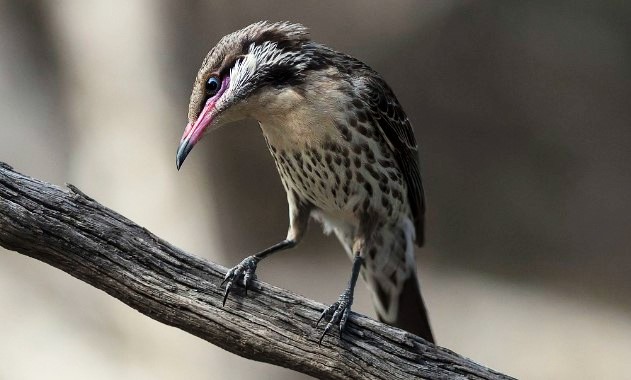Behavior and Habitats: The spiny-cheeked honeyeater (Acanthagenys rufogularis) is an elegant and large bird. There is nothing more beautiful than Mother Nature’s most beautiful bird with its striking pink-and-black bill. In the arid scrubs of inland Australia, this bird seems to have replaced wattlebirds. The species ranges through dry mallee and shrubby mulga, along creek washes, and into dense dune thickets. The spring-cheeked honeyeater is another name for it. Spiny-cheeked honeyeaters measure about 230–260 mm long and weigh around 52 grams. At seasonal flushes of flowering eucalypts, mistletoes, and extremophiles in the north, the birds wander locally and congregate in loose gatherings of 120 or more.
To reach outside foliage, spiny cheeks work quickly from within foliage to rip flowers or pick fruit. During the flight, spiny-cheeked honeyeaters dash from thicket to thicket, usually between and over trees. A strange variety of whistles, gurgling trills, and whines are often heard during feeding groups. Spiny-cheeked honeyeaters hold breeding and feeding territories and chase away trespassers. They contribute to pollination by feeding on nectar. In the summer, when the fruit is ripe, the bird will feed on the fruits pollinated by the birds. Additionally, seeds dispersed by a bird are more likely to germinate than seeds dispersed by humans.
Read More – Painted Honeyeater (Grantiella picta)

Nutrition: Besides fruit, spiny-cheeked honeyeaters eat peppercorns and cultivated fruits and peppers along the river’s central bank, as well as chenopods and mistletoe. This bird is primarily a frugivore, but it eats nectar, blossoms, insects, reptiles, and young birds as well. A hawking flight around a tree or shrubtop occasionally catches insects, either gleaned from foliage or caught in flight. Nevertheless, manna and nectar are staples of the diet. The permanent territory of several hectares is established by individuals and pairs wherever nectar and fruit are available year-round. The range of insects are used to build protein in the young, which are fed by both parents, but only the female can brood.
Identifying information: Both sexes of adults are similar, but the male is larger. Except for the rump, the upper part is brown-grey with dusky streaks, plainer on the crown; the rump is off-white. The feathers of the wings are finely edged, citrine-white, with a deeper grey-brown color. All tail feathers except the central pair are broad-tipped white. Furthermore, there is a dusky line from the lords to the sides of the head, a broad swathe of white spiny feathers across the cheeks, and a dusky malar line from the mouth to the sides of the neck, flecked with dusky and white feathers across the neck. Cinnamon on the chin and upper breast; yellowish cream on the lower breast and undertail. There is a grayish-pink eyering surrounding her blue eyes. A black tip is on the bill, and the base and gape are pink-red. The feet are a dark gray color. In maturity, cheeks were washed yellow, and eyes were browner than in adults. Over the course of several months, the cheeks become whiter.

Call & Song: As territorial markers, Spiny-cheeked honeyeaters call with bubbled trills, gurgles, and whistles; in alarm and in contact between pairs, they make a sharp, clipped tok. During song flights, birds are seen fluttering near vertically up from a tree or bush, singing, then swooping back to cover. Song: Prolonged bubbled trills, gurgles, and whines, often beginning with a rising widit, wid-11-id-ll-it, and ending in falling whines, pee-peer, pee-peer, pee-peer. Both sexes contribute to the sound both in flight and from perches, often in duets.
Nesting and Breeding: In eastern and southern Australia, nesting and breeding occur between July and January; elsewhere, it is irregular. This nest is a lightly built cup of long grasses and plant stalks, usually worked in from rim to bottom, crossing each other from top to bottom. The thin forked branches are 1–13 meters above the ground, fastened at the rim of the nest by cobwebs.
Read More: Graceful Honeyeater (Meliphaga gracilis)

Eggs: The bird usually lays two eggs laid by the honeyeater, which are a pale cream-brown or olive color with sparse brown markings and underlying blue-grey coloration. Approximately 25 x 18 mm in size, eggs are oval in shape. Females incubate for about 14 days. In about 15 days, the young fled.
Distribution: The spiny-cheeked honeyeater is found mainly in woodlands and scrubby dunes in dry inland regions, south to the central south coast, and Kangaroo Island, SA. There are more pronounced northward movements in winter in the Selwyn Range and Gulf District, Queensland, while in the south it is predominantly sedentary or locally nomadic. In addition to managed and cultivated lands, the birds also inhabit pasture lands, consisting of grasses such as sedges, rushes, arrow grasses, and quillwort. The honeyeater is sometimes found in orchards and mangroves.
Family: The spiny-cheeked honeyeater (Acanthagenys rufogularis) belongs to the family Meliphagidae and is the only species in the genus Acanthagenys.
Races: There are no races.

Read More – White-fronted Honeyeater (Phylidonyris albifrons)






